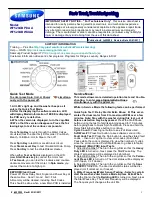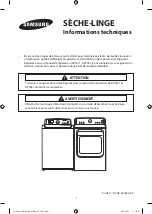
19
I.4
Instructions for use and maintenance
Risks mainly of a mechanical, thermal and electrical nature
exist in the machine. Where possible the risks have been
neutralised:
• directly, by means of adequate design solutions.
• indirectly by using guards, protection and safety devices.
Any anomalous situations are signalled on the control panel
display.
During maintenance several risks remain, as these could not
be eliminated, and must be neutralised by adopting specific
measures and precautions.
Do not carry out any checking, cleaning, repair or maintenance
operations on moving parts. Workers must be informed of this
prohibition by means of clearly visible signs.
To guarantee machine efficiency and correct operation,
periodical maintenance must be carried out according to the
instructions given in this manual.
Make sure to periodically check correct operation of all the
safety devices and the insulation of electrical cables, which
must be replaced if damaged.
WARNING
Extraordinary machine mainte-
nance operations must only be
carried out by specialised per-
sonnel provided with all the
appropriate personal protection
equipment (safety shoes, gloves,
glasses, overalls, etc.), tools,
utensils and ancillary means.
WARNING
Never
operate
the
machine,
removing, modifying or tamper-
ing with the guards, protection or
safety devices.
Before carrying out any opera-
tion on the machine, always
consult the manual, which gives
the correct procedures and con-
tains important information on
safety.
I.5
Reasonably foreseeable improper use
Improper use is any use different from that specified in this
manual. During machine operation, other types of work or
activities deemed improper and that in general can involve
risks for the safety of operators and damage to the appliance
are not allowed. Reasonably foreseeable improper use
includes:
• lack of machine maintenance, cleaning and periodical
checks;
• structural changes or modifications to the operating logic;
• tampering with the guards or safety devices;
• failure to use personal protection equipment by operators,
specialised personnel and maintenance personnel;
• failure to use suitable accessories (e. g. use of unsuitable
equipment or ladders);
• keeping combustible or flammable materials, or in any case
materials not compatible with or pertinent to the work, near
the machine;
• wrong machine installation;
• placing in the machine any objects or things not compatible
with its use, or that can damage the machine, cause injury
or pollute the environment;
• climbing on the machine;
• non-compliance with the requirements for correct machine
use;
• other actions that give rise to risks not eliminable by the
Manufacturer.
WARNING
The previously described actions
are prohibited!
I.6
Residual risks
The machine has several risks that were not completely
eliminated from a design standpoint or with the installation of
adequate protection devices. Nevertheless, through this
manual the Manufacturer has taken steps to inform operators
of such risks, carefully indicating the personal protection
equipment to be used by them. In order to reduce the risks,
provide for sufficient spaces while installing the unit. To
preserve these conditions, the areas around the machine
must always be:
• kept free of obstacles (e.g. ladders, tools, containers, boxes,
etc.);
• clean and dry;
• well lit.
For the Customer's complete information, the residual risks
remaining on the machine are indicated below: such situations
are deemed improper and therefore strictly forbidden.
Residual risk
Description of hazardous
situation
Slipping or falling
The operator can slip due to water
or dirt on the floor
Catching, dragging or
crushing
Catching or dragging of the oper-
ator or other persons in the drive,
during the machine work phase,
due to improper actions, such as:
• placing an arm inside the
machine to remove a stuck rack
without stopping the machine
by operating an emergency
switch;
• accessing the rack handling
system without stopping the
machine by operating an emer-
gency switch.
Use of improper clothing with
loose parts (e.g. necklaces,
scarves, shawls, ties, etc.) or long
hair not gathered, which could get
caught up in moving parts.
Burns/abrasions (e.g.
heating elements,
cold pan, cooling cir-
cuit plates and pipes)
The operator deliberately or unin-
tentionally touches some
components inside the machine
without using protective gloves.
Stab wounds
The operator deliberately or unin-
tentionally touches some
components with sharp edges
during the machine cleaning with-
out using protective gloves.
Burns
The operator deliberately or unin-
tentionally touches some
components inside the machine or
dishes at the outfeed without using
gloves or without allowing them to
cool.
Shearing of upper
limbs
The operator violently closes the
front panels.










































